Combining history with bruises
Performing Viking games and the entertainment of common people way before the computer, the Telge Glima group introduces outrageous, daring acts.
-
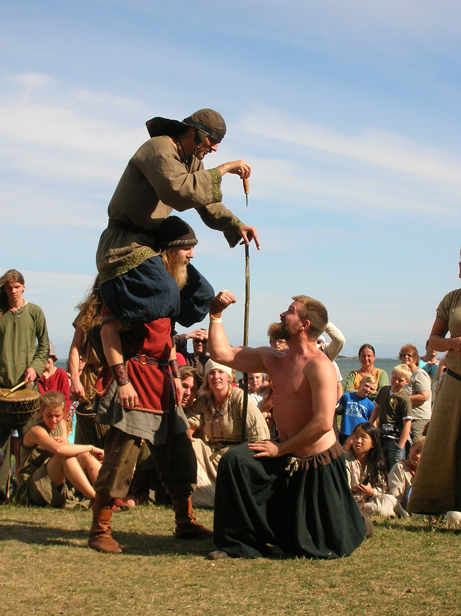 Historical accuracy isn’t all; what’s more important is that the game is fun and safe.
Historical accuracy isn’t all; what’s more important is that the game is fun and safe. -
-
by Michael Maasing, Eva Stenskär
-
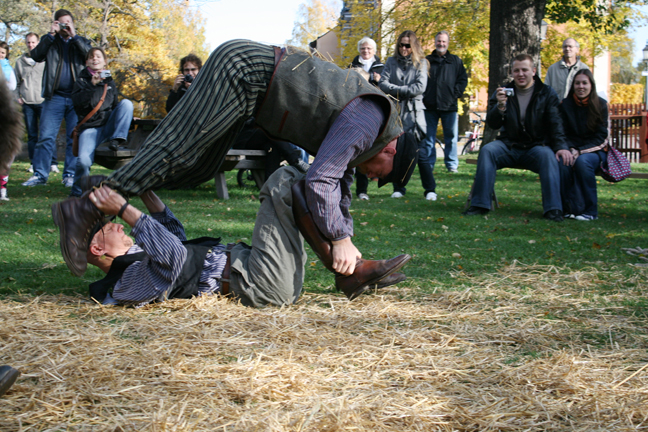 Turning the big wheel. This peasant style game stems from Gotland and the 19th century. You turn your “big wheel” (two people make a wheel) a certain distance, and whoever gets there first with his wheel, wins.
Turning the big wheel. This peasant style game stems from Gotland and the 19th century. You turn your “big wheel” (two people make a wheel) a certain distance, and whoever gets there first with his wheel, wins. -
-
>b>Telge Glima will be at ScanFest in Vasa Park, Budd Lake, NJ on Aug. 31 - Scandinavian Fest
-
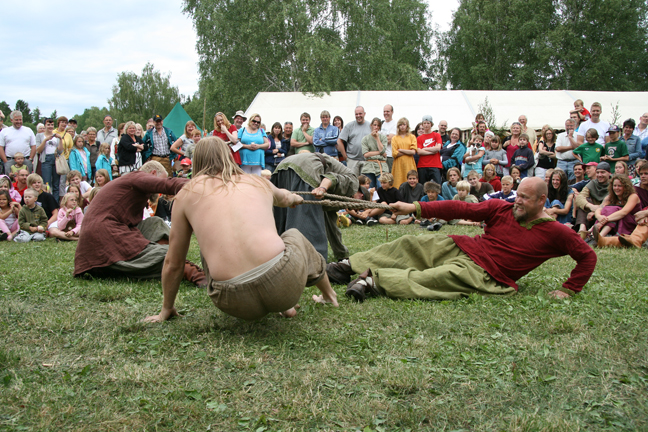 Four-person tug-of-war. A game with medieval origins where the point is to reach your own corner first.
Four-person tug-of-war. A game with medieval origins where the point is to reach your own corner first. -
The Vikings sure can stir your imagination. During their heyday they roamed the seas, explored unknown territories, traded gold with the Arabs and … played blind man’s buff? Such a simple children’s game perhaps doesn't gel with romantic notions of our strong forefathers, nevertheless even the Vikings had to unbutton and unwind. And what better way to have fun than with some games and a round of mead? Because there were many games – and thanks to a group called Telge Glíma, they are being given a second chance today.
Telge Glíma began in 1990 in Södertälje, Sweden, when a group of friends with mutual interests in history and working out joined together. One of them was Michael Maasing, who explains that their activities at first centered around the old Viking wrestling form glíma, which for many years was extinct in all Scandinavia countries bar Iceland, where it’s been played uninterruptedly since the time of the Vikings and where it is the national sport.
“We began with glíma but then we discovered a treasure of old games and sports, and decided to widen our horizons. A few of us work at museums and comb through ethnological writings on a regular basis, in search of descriptions of games and sports. Then when we meet next time, we practice the games we’ve read about.”
But historical accuracy isn’t all; what’s more important is that the game is fun and safe. According to Maasing, many of today’s familiar games are actually quite ancient.
“Herre på täppan or King of the Hill is a very old game, as is tug-of-war and bowling. Some of the games they played then have become sports today. Tresteg (triple jump), for instance, is something farmers in the 14th century did for fun.”
One of Telge Glíma’s activities is performing. Dressed up like peasants of 150 years ago, you can see them present games like Badger the Bear, Hitting the Jug or Master of the Circle at open-air museums like Stockholm’s Skansen or Old Linköping. Or perhaps you’ll come across them at a medieval festival performing even older games, like backwards leaps, tug-of-war or glíma.
“We’re performing the games of the people,” says Maasing, “not the upper class. Which means not much was required prop-wise, a stick, a rope, your own body. With these simple means you can practice hundreds of different games and sports that test your agility, swiftness, strength, hardness and flexibility, for yourself, against others or in groups. Some of the games are more violent than others but most of them are games everyone can try.” -
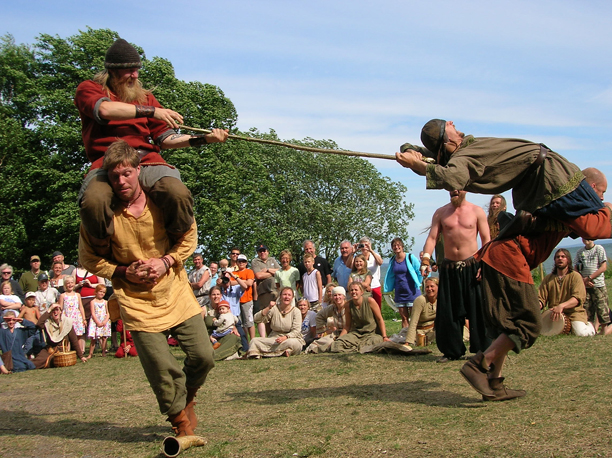 Pull the sun over the mountain. An old tug-of-war between teams which originates in the regions of the northern Alps. The game is said to symbolize the time of year, when the sun doesn’t reach the mountain ridges, but people are willing to do what they can to help it do so.
Pull the sun over the mountain. An old tug-of-war between teams which originates in the regions of the northern Alps. The game is said to symbolize the time of year, when the sun doesn’t reach the mountain ridges, but people are willing to do what they can to help it do so. -
How are these games described? What on earth is Dra Orvars Ben? And how do you play a game named Daska Markus? Or Blåsa mynt ? And what is known about them?
“Well, Dra Orvars Ben (Pull Orvar’s Leg) is a tug-of-war type of game originally from Belgium, where two teams pull a member holding a stick. Similar games existed in Scandinavia in the 19th century. Daska Markus (Spanking Markus) is a Swedish game of unknown age for two players. They are both blindfolded and ask each other questions according to old sayings. That’s the first part. In the second part, the one asking spanks the one answering with a straw-filled sack. In this game you have to listen carefully. In Blåsa mynt (Blow the Coin) a coin has to be blown at from one bowl to the next until it has gone full circle. Sometimes the bowls are filled with water that first must to be blown out, which increases the difficulty. Blåsa mynt is a Swedish game from the 19th century.”
There are currently 25 members in Telge Glíma, they range in age from 25 to 50 and have different backgrounds.
“We are blacksmiths, chiropractors, bus drivers, web designers, firefighters, computer salesmen and so on. And there are about ten or twelve women among us,” Maasing says. “What we all have in common is a love of combining history with bruises!”
While three or four of Telge Glíma’s members research books to find more games and sports, the entire group – or parts of it – go on tours throughout Northern Europe.
“We visit at least 4 or 5 different places every year,” Maasing continues. “Here in Scandinavia, Poland, Estonia, Russia … some parts are better than others in keeping games alive. Gotland, for instance, is a good example. They still play a lot of their old games, like pärk (a game somewhat similar to tennis but with two teams of seven people on a large field. The players hit or kick the ball, which is made of a tight ball of yarn that has been dressed in sheepskin. The pärk itself, a square made of wooden laths, serves as a form of serve ground). When traveling abroad we learn a lot, and discover that we share many of our games with other countries. Sometimes it’s difficult to decipher exactly how a game was played just by reading about it, but when we travel we discover other people who have figured it out, and vice versa. We learn that way.”
Telge Glíma also performs at bachelor parties, private gatherings for companies and at schools, showing games that children can easily mimic. They also meet with each other and have friendly competitions.
“We want to encourage a zest for playing and a curiosity about our past,” Maasing says. “These games and sports are part of our national heritage.” -
 Pull Orvar’s leg. Another tug-of-war game from Belgium where two teams compete with each other and where the participants carry sticks. There are similar games from19th century Scandinavia.
Pull Orvar’s leg. Another tug-of-war game from Belgium where two teams compete with each other and where the participants carry sticks. There are similar games from19th century Scandinavia. -
For more info, see www.telgeglima.com
-
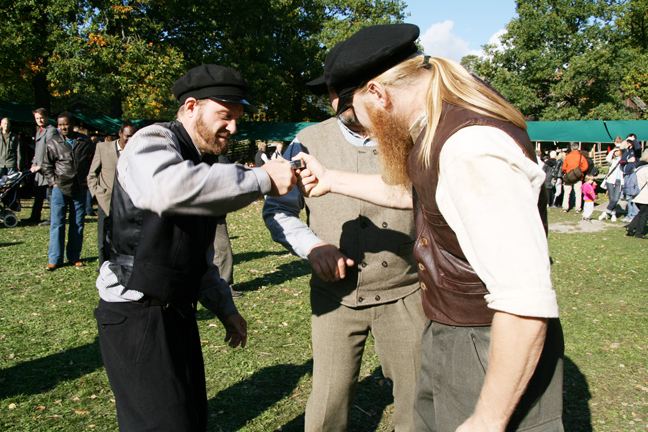 Snuff tug-of war. A typical Swedish game from the 19th century, a tug-of-war over a metal snuffbox. Farmhands often challenged the shop manager to a game of snuff tug-of-war in the hopes of winning the snuff for free.
Snuff tug-of war. A typical Swedish game from the 19th century, a tug-of-war over a metal snuffbox. Farmhands often challenged the shop manager to a game of snuff tug-of-war in the hopes of winning the snuff for free. -
More on Glíma
Being strong and fit for active service were important qualities for a Viking, and thus glíma is an important part of our Viking heritage. Glíma can be translated as a struggle. Bringing an opponent down without weapon, glíma is an umbrella term for three different grips: Trouser Grip, Back-hold and Free Grip, but it’s all about bringing your opponent down without the use of weaponry. The oldest text about the ritual ceremonies surrounding glíma can be found in “The Edda,” written during the 1220’s by the Icelandic master poet Snorri Sturluson. The International Glíma Association (IGA) is the global organization uniting all people and groups interested in glíma.
www.internationalglima.com
The Viking Glima Federation (VGF) is the international organization that deals with Glíma as a Martial Art.
www.viking-glima.com -
The first world championship in Glíma was held in Roskilde, Denmark, in August 2008, where Swede David Lundholm took third place in the group Men –81 kg. Women, too, compete in glíma and the current world champion is Johanna Gudrun Magnusdottir from Iceland. The next world championship will be held this September in Iceland.
Although dead for many years in Sweden, today some 30 Swedes practice glíma — thanks to Lars Magnus Enoksen, who founded a glíma section at a club for wrestling in Malmö 20 years ago, and who has been both Swedish and Nordic glíma champion. Today, Enoksen is the president and chief instructor of the Viking Glíma Federation. He has also written many books about the sport.
www.glima.se -
-
